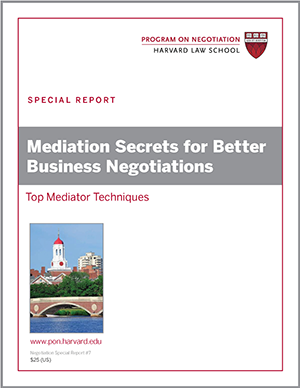
If you manage people, disputes will show up at your door. The marketing VP protests that the budget cap you and your new finance VP proposed is hindering a research initiative you supported. Two young sales representatives are embroiled in a turf war. Your administrative assistant is upset because the HR director won’t approve the extra week of paid maternity leave you promised her.
Fail to address such employee concerns and you’ve failed as a leader. But it can be difficult to know how to respond, especially when you have a stake in the problem. Sometimes third-party intervention can make matters worse.
In recent years, managers have begun to adopt the proven skills that a professional mediator would use to resolve workplace conflict. In his book Leading Leaders: How to Manage Smart, Talented, Rich, and Powerful People (Amacom, 2006), Tufts University professor Jeswald Salacuse shows how mediation and other alternative dispute-resolution techniques can defuse tensions and get everyone back to work.
Using mediation skills as a leader
In traditional mediation, a trained mediator works to try to help disputants find common ground using principles of collaborative, mutual-gains negotiation. Rather than imposing a decision, a trained mediator applies communication skills, objectivity, and creativity to help disputants reach their own voluntary solution to the conflict (for more information on the mediation skills necessary to resolve complicated disputes, see also: What Makes a Good Mediator?).
The mediator typically does so by encouraging disputants to move beyond their entrenched positions and explore the deeper interests underlying their dispute (see also, Negotiation Research on Mediation Techniques: Focus on Interests). For example, the two salespeople’s turf battle over scarce resources may involve deeper insecurities about their positions in the organization. By revealing their underlying interests, disputants in a mediation can find opportunities for value-creating tradeoffs, often without having to make significant concessions. Simply allowing hurt or angry feelings to air can lead negotiators to become more flexible regarding their surface-level positions.
Leaders who have engaged in negotiation training likely already have acquired good mediation skills that position them to successfully resolve conflicts among their subordinates. But there are notable differences between the role of a professional mediator and the role of a leader mediating an employee dispute (for more information on mediating employee disputes, see also Resolve Employee Disputes Using Mediation Techniques). First, unlike an actual mediator, you’ll have to live with the outcome of the dispute on a daily basis. Your personal allegiances and objectives may lead you to have strong opinions about the best result. In addition, the negotiated solution must satisfy the interests of the broader organization as well as those of the disputants. For these reasons, leaders need to adapt mediation skills to their purposes (for more on mediation and win-win, integrative negotiation strategies, see also: How Win-Win Integrative Negotiations Strategies Enable Negotiators to Breakdown Barriers to Agreement at the Bargaining Table).
6 bases of power
In addition to applying fundamental principles mutual-gains negotiation, leaders can draw on the following six specific bases of social power when using mediation techniques to resolve employee disputes, according to Salacuse.
1. Rewards.
As a leader, you have access to resources you can use to reward disputants for changing their behavior. Suppose you have been so impressed by your marketing VP’s achievements that you’re committed to funding the research initiative despite the budget cap that your finance VP wants to enforce. As CEO, you may be able to tap special funds for the project without requiring an exception to the rule. Anticipate, however, that some in your organization may view such special arrangements and rewards as a sign of weakness or as a bad precedent.
2. Coercion.
Leaders can punish as well as reward, notes Salacuse. If you are tired of your sales reps’ constant bickering over who poached whose client, you could threaten to take away key accounts from both if they can’t work out a solution. But be careful not to be too heavy-handed with coercion tactics, lest you drive the conflict deeper and closer to home.
3. Expertise.
Often, subordinates bring their disputes to their bosses because they expect them to apply specialized expertise to a problem. Your managerial smarts should convince your finance VP to accept your support of the marketing VP’s new initiative. Lawyers, doctors, and other professionals bring unique knowledge and skills to the conflicts in their offices. Salacuse warns, however, that disputants may be dismissive of your recommendations if they perceive your expertise to be no greater than theirs.
4. Legitimacy.
A leader’s legitimacy varies by organization and by the nature of the dispute. In a top-down organization, employees will be more likely to accept the guidance of an authority figure than employees of a less-hierarchical firm will be. If your HR director is used to having a great deal of autonomy, he may fight back if you lobby for your assistant to receive an extra week’s maternity leave.
5. Relationships.
The degree to which you can influence a disputant also depends on the nature and strength of your relationship with that person. Suppose you decide that you erred in offering your assistant a longer maternity leave than other employees. You should have a better chance of persuading her to accept this view if she has worked closely with you for 10 years than if she only joined the organization a year ago. The desire to preserve the relationship can be sufficient motivation for a disputant to follow your advice.
6. Coalitions and networks.
Sometimes outside help is required to effectively resolve a dispute. By building coalitions and capitalizing on existing social networks, you can gain support for your proposal, Salacuse writes. For instance, if you are relatively new to your organization, you might ask a senior partner who has worked closely with at least one of the two warring sales reps to help you resolve the conflict.
Related Mediation Article(s): Mediation Techniques for Conflict Resolution Using Online Mediation
Adapted from the article “Resolve Employee Conflicts with Mediation Techniques,” first published in the Negotiation Briefings newsletter.




